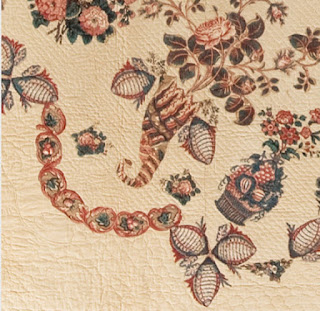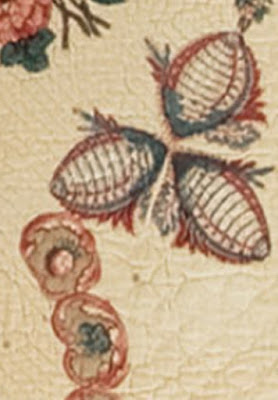Panel #16, this bouquet of flowers with four stems, is a small panel and not very common. All our examples seem to be American in style and location.
The bouquet has a circular frame, a simple ring pinned by 8 oval ornaments.
Our photo above was digitally stitched by Dawn Ronningen with thanks to Terry Terrell, the North Carolina Museum of History & the North Carolina quilt project. Dawn took the half panels in the first border on the quilt below and reconstructed Panel #16.
Quilt by Margaret Jennet Harris Shell
North Carolina Museum of History
The central panel here is #1 with a primrose spray in the center.
We have a snapshot of a block-style chintz quilt in the collection of the Charlotte, North Carolina Museum of History with 8 examples of Panel #16. The spiky leaves offer a visual cue. Other small panels in this quilt are #6 and #17
We can see the unknown quiltmaker used a large chintz floral
for the border and added a few panel corners, the triangular shapes,
to fill in some space with double line and diagonal grid quilting.
.
Collection of the International Quilt Study Group & Museum # 2006-003-0002
Blowing up their online picture gives us a good view of the trimmed floral image.
A Tree of Life chintz applique found in the North Carolina project is attributed to Cynthia Clementine Brantley Johnston of Mooresville in Iredell County, North Carolina. The bouquet is included as foliage at least four times with the popular palm tree print in there twice....
and two pheasants. Those triangular leaves could be cut from the panel's corners.
Sort of like this.
Long leaves echo the palm fronds
See the Quilt Index file:
The maker's identity seems confused as Cynthia Clementine Brantley Johnston was born in 1860 and died in 1949, much too young to have made this quilt in style fashionable 30 years before her birth.
We often get the feeling these Southern panel
quilts were made by professional seamstresses
but this one----Not so much. The details seem
a wonder of improvisation with a limited supply of chintz.
A Mary Clementine Brantley Johnston with corresponding birth and death dates may be the woman who owned the quilt. Her daughter was named Cynthia and her mother was Jane Creswell McNeely Brantley (1821 -1899?), a more likely candidate for quiltmaker. Yet Jane seems a bit young to have sewn such a complex quilt in her teens so it may have been the work of her mother Elizabeth Creswell McNeely (1796-1877). Or perhaps it was a purchase. Another option: stitched by seamstresses free or slave at McNeely family commission.
Our fifth quilt is again just a snapshot, a rather graceful chintz medallion
with the panel in the center area with Panel #14.
UPDATE: In the comments faithful reader Terry Terrell directed us to this album quilt in the collection of the North Carolina Museum of History. It was made by members of Anna Caswell White's Raleigh family and friends from other places, dated 1846-1849. In the central Mariner's Compass block is panel #16 in its circular frame.
Here's a link to the file
What Can We Learn from Panel #16?
The catalog records at IQSCM tell us nothing about its origins, but we would guess it is a Southern quilt dating from about 1825-1850. Clues in the other fabrics such as the border print, a primrose path, back up that date. See the file here:
http://barbarabrackman.blogspot.com/2018/08/primrose-path-1-chintz-stripe-new.html
Like the Brantley family quilt from North Carolina this one seems to be the idiosyncratic work of one individual (at least in the planning rather than the stitching). She's adapted shapes to create line and color in the composition.
We recognize the kidney bean scallops as part of Panel #5
the fruit basket. But what are those white shell-like shapes?
So what can we learn? Some of the panel quilts have the style of professional seamstresses who sold bedcoverings to wealthy Southerners, but this one looks like a one-of-a-kind arranged by an amateur.
See more about the pheasants and palms:
http://barbarabrackman.blogspot.com/2018/06/pheasant-palm-chintz-4-dating-quilts.html






















I'm sure those white shell like shapes were meant to be shells, but the look like the underside of a wood beetle to me.
ReplyDeleteThe North Carolina Museum of History also has a Mariners Compass quilt (H.2002.66.1) with Panel 16 used as the center of the middle compass in the quilt. The corners of the panel are trimmed off.
ReplyDeleteFun to see the kidney bean scallops from the fruit basket medallion used here. One of the fruit basket medallion quilts in our book uses these same shapes to make cornucopias. There are probably still undiscovered (by us) quilts out there where these small snippets of the borders are used imaginatively. I had wondered about what had happened to the borders, as many quilts use the medallions without the borders. I am starting to get a better picture. Thanks again.
ReplyDelete